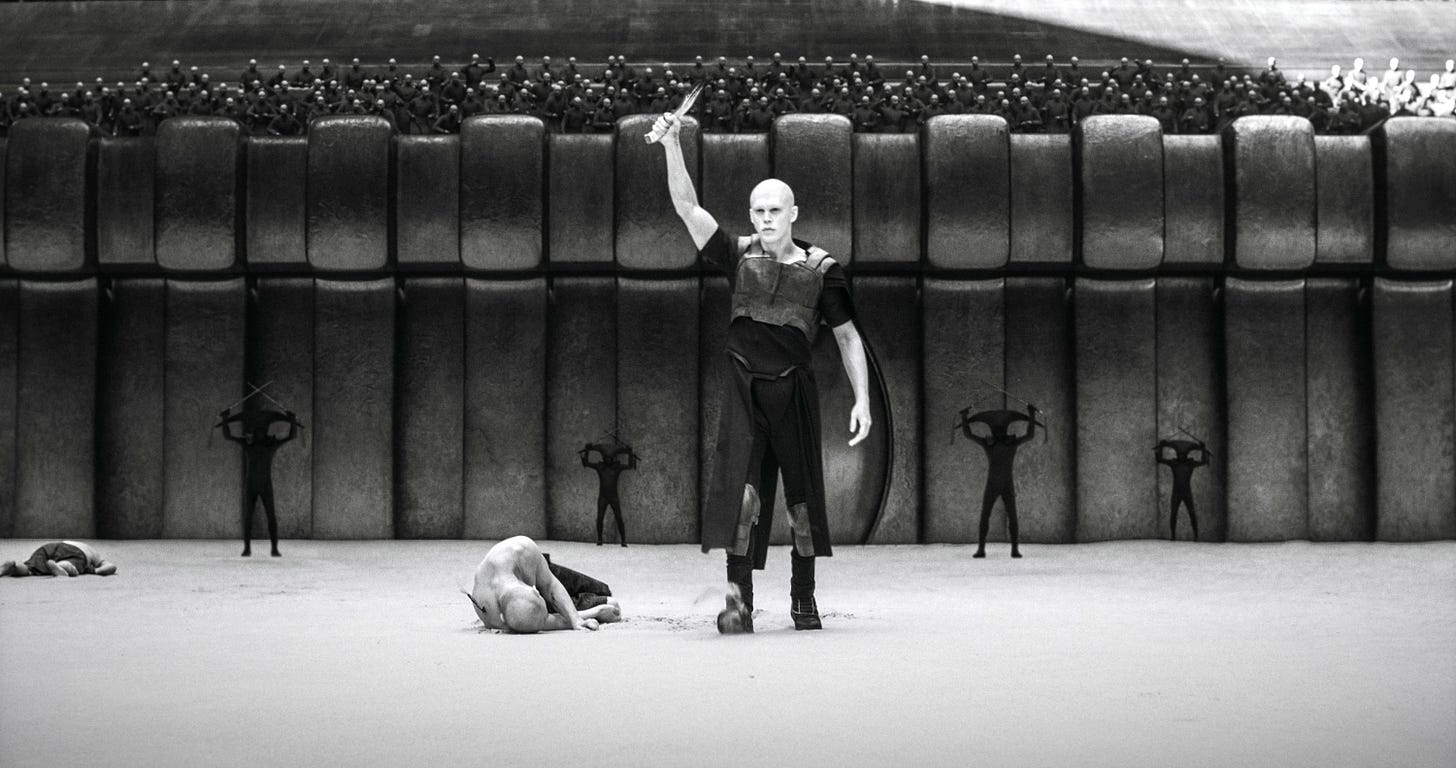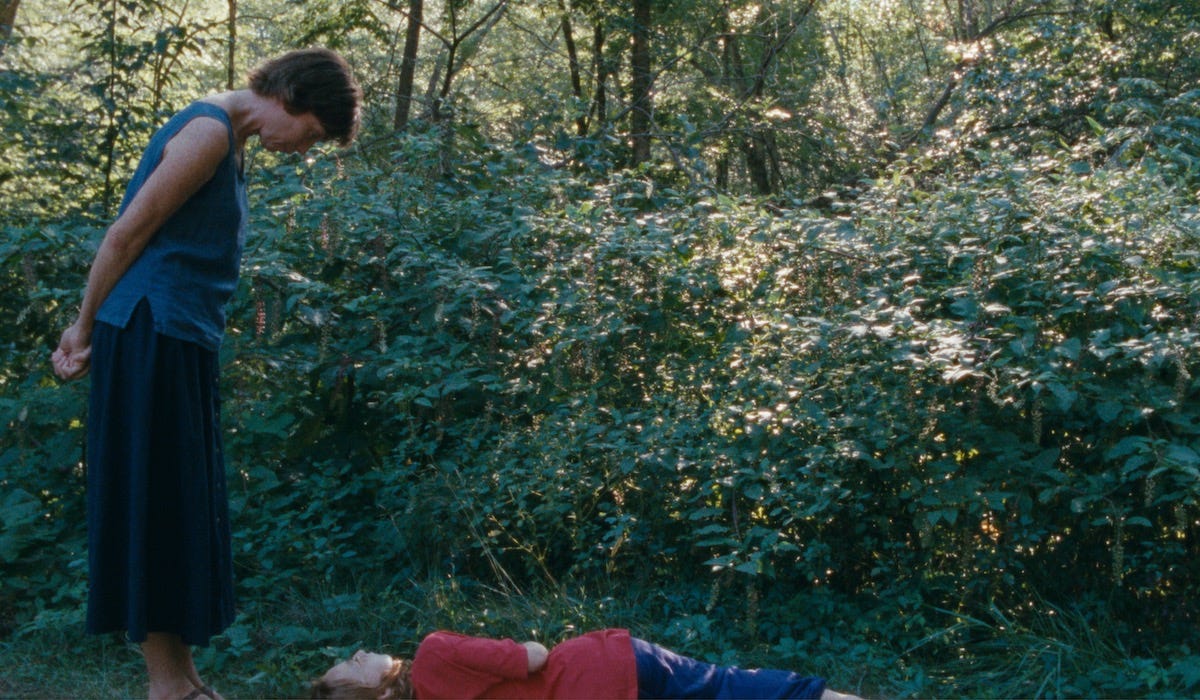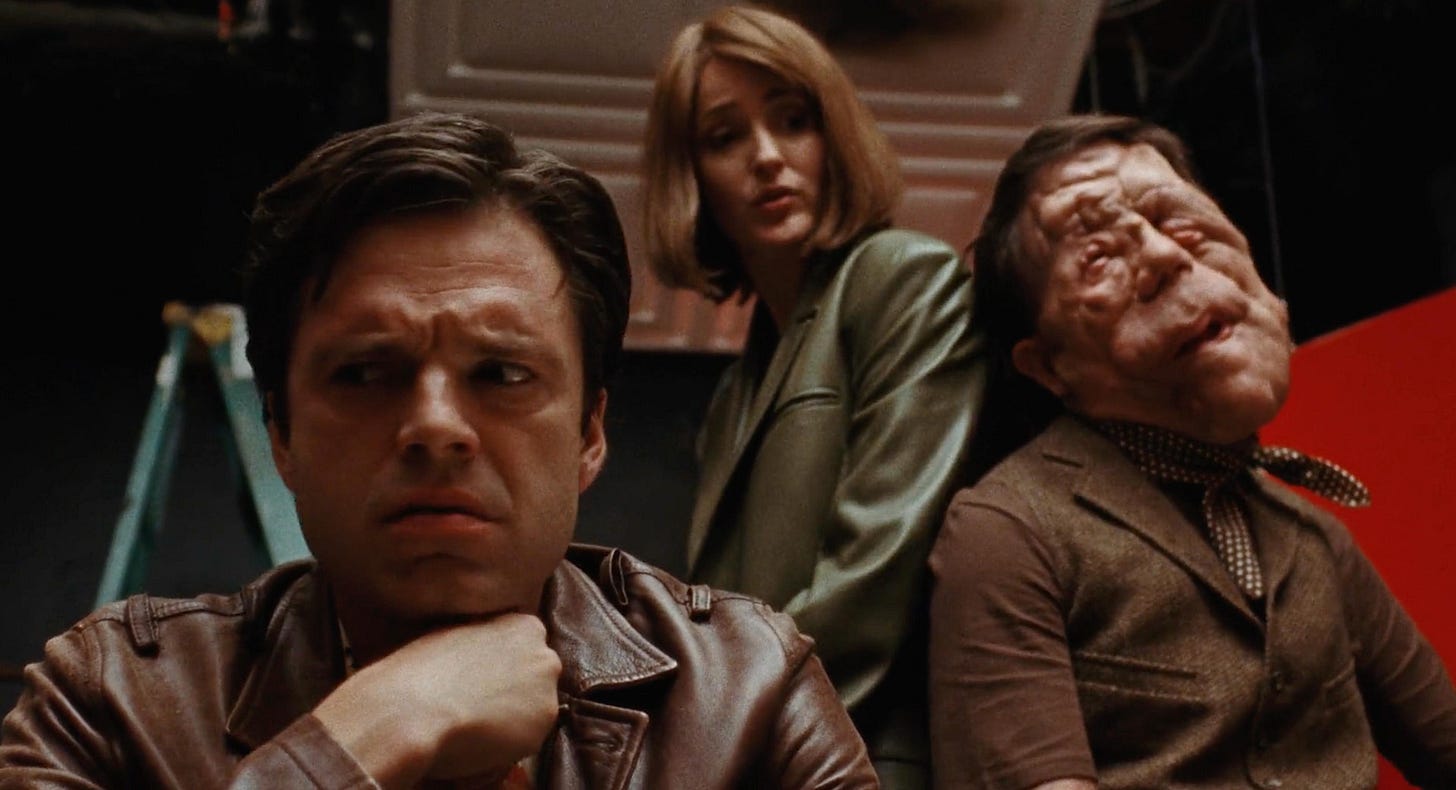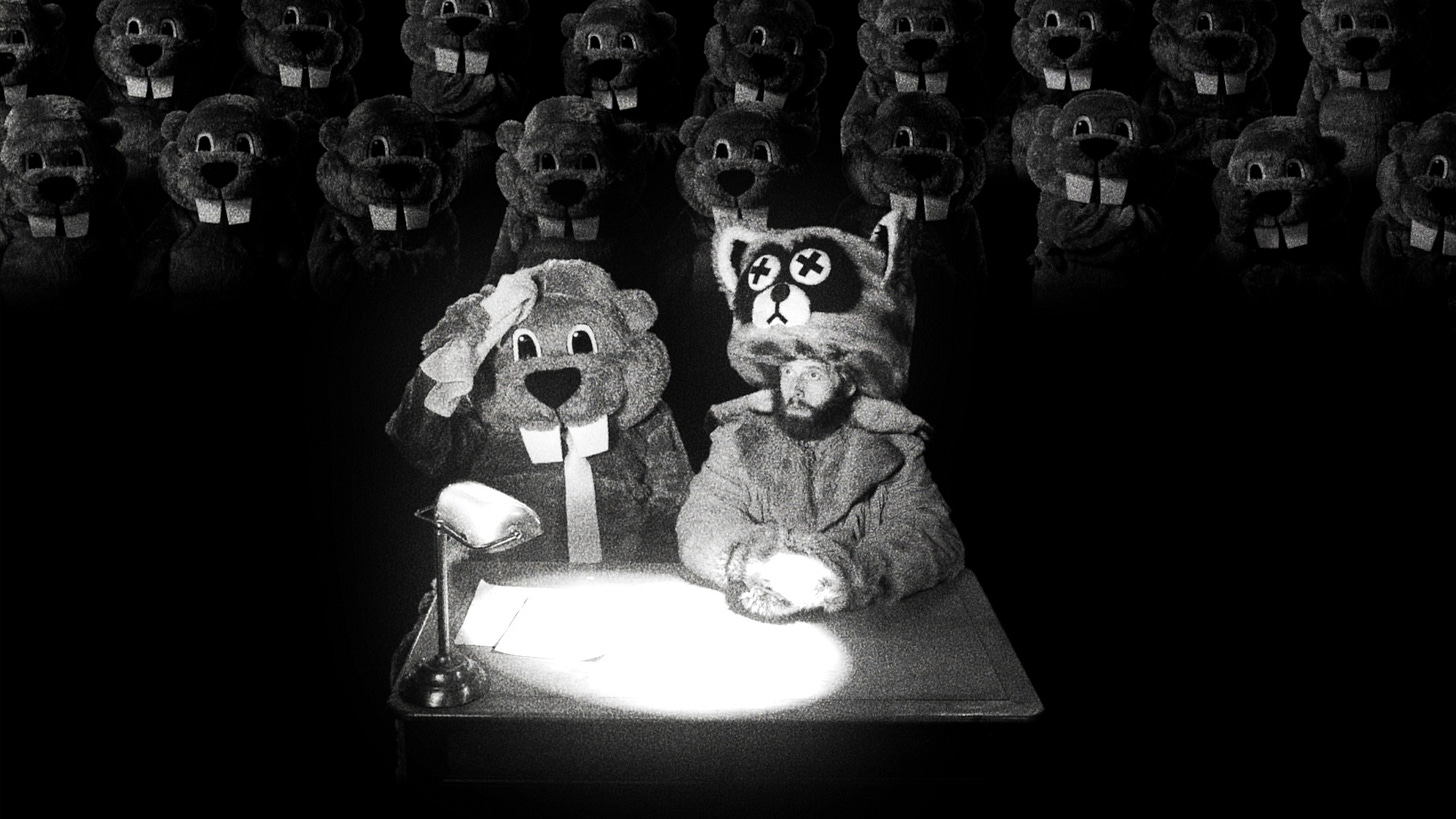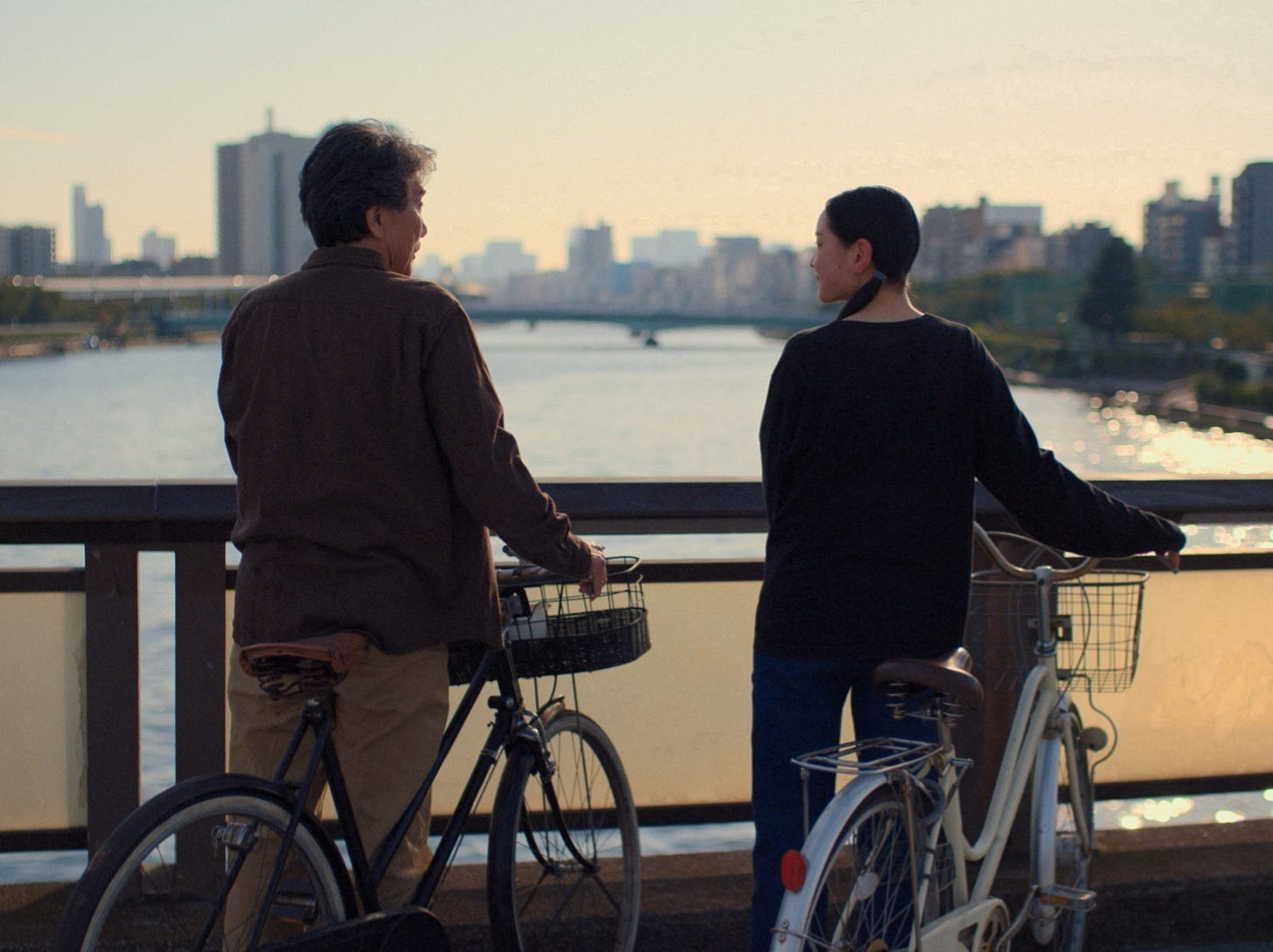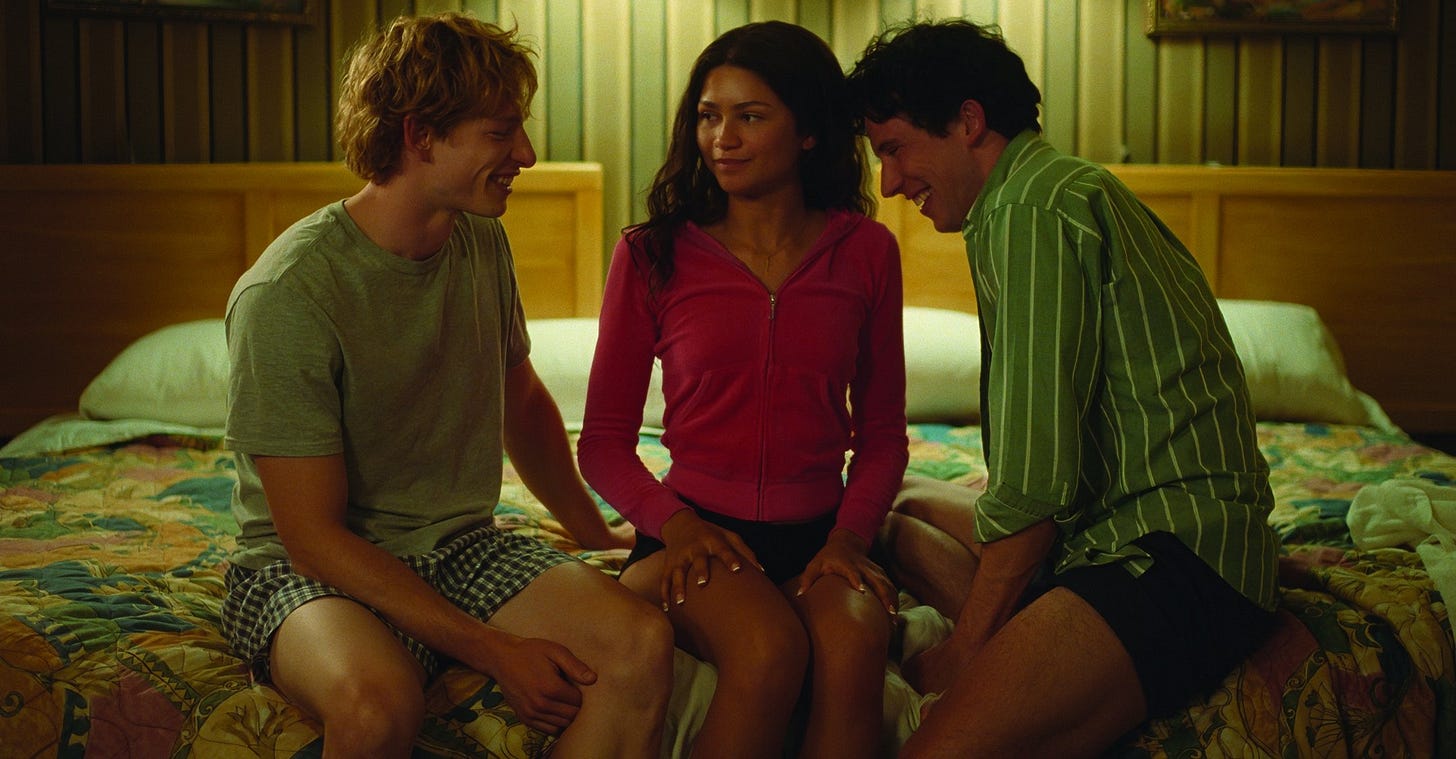Best of 2024
Howdy Schlubs!
During the actors’ and writers' strikes of 2023, the movie industry adopted the mantra of “Survive till 25.” This was in reference to the expected drop in quality caused by not having writers on set and the production delays that left actors unable to walk the red carpet. I think that mantra is unfair to the quality of films released in 2024. It may not have had the flash of “Barbenheimer,” but I was sweating a bit while deciding who to cut from my Top Ten—always a good sign.
You might have noticed that this list doesn’t have the usual video compilation accompanying it. Sadly, after completing the compilation in late January, my laptop bricked before I could properly export it. Completely crashed. I lost the entire video and weeks of work. So to tell you guys the truth, I don’t have the time or the heart to do it from scratch.
Instead, I hope you enjoy this list and take the time to watch one or two things off it. Hearing that someone watched a piece of Schlub Cinema is a balm for my soul—like the first sip of a Lone Star at your favorite dive, or when someone saves your life with a drunk cigarette <3
Thanks again for reading—your support, as always, means the world to me.
Note: this list is based on American release dates.
Honorable Mention: The Conner O'Malley Project
Comedian Conner O’Malley has become a stamp of quality for each project he crashes into. I’ve long been a fan of his specific brand of psychosis, from his deranged YouTube output to his gentler role in Joe Pera Talks With You, but 2024 was the year to bet big on O’Malley. His short film Coreys was an Andrew Tate-style Vegas nightmare, featuring Academy-worthy prosthetics and one of the funniest line deliveries of the year.1 His stand-up special, Stand Up Solutions, was a cheerfully grim look into the AI-obsessed losers who now run our society. Even outside of his own projects, O’Malley was a welcome surprise—like in Jane Schoenbrun’s unfortunately mixed I Saw The TV Glow.2 What sealed the deal on putting O’Malley on this list was Rap World, a feature film co-directed by him and Danny Scharar. A painfully accurate depiction of upper-middle-class suburbia in 2009, Rap World unlocked key memories of my middle school weekends smoking weed out of Dr Pepper cans and acting strange at house parties. Filmed on a grainy DV Camera (you know I love that), Rap World follows three townie friends (Conner O'Malley, Jack Bensinger, and Eric Rahill) attempting to record a rap album in one night. It’s as messy and uncomfortable as it is funny, with a sappy sincerity running beneath the surface. O’Malley and his contemporaries have long been powerhouses on YouTube, but hopefully, his 2024 output puts him one step closer to the big screen.
Coreys, Stand Up Solutions, and Rap World are all available to stream for free on YouTube.
10. Janet Planet
Annie Baker’s Janet Planet shouldn’t have worked for me. I’m not one for hippy navel-gazing, and precocious kids are often a death sentence for my patience—but Janet Planet broke my prejudices. Set in 1991, deep within the Massachusetts forest, Janet Planet follows Lacy (Zoe Ziegler), a somber eleven-year-old living with her freewheeling acupuncturist mother, Janet (Julianne Nicholson). As the title suggests, Janet has a gravitational pull—drawing various human detritus into her orbit: lovers, exes, cult leaders, and rent-strapped roommates, all of whom form the chapter-like structure of the movie. Lacy, the audience surrogate and POV, watches with apathy and frustration as strangers enter and leave her home in a consistent rhythm—often only chiming in when her mother asks her for relationship advice. In her review for Autostraddle, Drew Burnett Gregory describes Lacy as, “...a dramatic, intense child, but she expresses her feelings quietly.” The same could describe the movie as a whole. This is a quiet movie, existing in the cicada-tinged summertimes of our childhood memories, but director Baker has the style and know-how to cut through the meditative atmosphere when it counts. The post-hippie art communes that Janet and Lacy wander through are textured and kinetic enough to sway any would-be-”square,” and Janet’s first onscreen boyfriend, Wayne (Will Patton), is genuinely frightening, depicted as some Deadhead-turned-ogre skulking in the shadows of Lacy’s woodland home. Janet’s allure, a warmth that forms the structure of the movie, is even interrogated, as Janet wonders aloud to Lacy, “I’ve always had this knowledge that I could make any man fall in love with me if I really tried, and I think maybe it’s ruined my life.”3
Janet Planet is streaming on Max.
9. A Different Man
It ain’t easy for handsome men these days. Think of the hunks of the MCU: out of the dozens of chiseled chads who donned the spandex, most are slumming it in movies like The Grey Man or Red Notice—movies that exist only in the tax reports of tech giants. Surprisingly, Sebastian Stan is one of the few Marvel graduates gambling on interesting choices. That gamble pays off big time in Aaron Schimberg’s A Different Man—a sadistically funny New York nightmare. Edward (Sebastian Stan), a struggling and self-conscious actor whose face has been disfigured by neurofibromatosis, finds an experimental treatment that melts away his facial tumors and leaves him with a chiseled mug. The newly yassified Edward fakes his death and leaves his old identity behind…until a woman from his past, Ingrid (Renate Reinsve), writes an off-Broadway play based on his life and death. Even worse, another man is in the running for the lead role: Oswald (Adam Pearson), an effortlessly charming mensch with the same neurofibromatosis that Edward worked so hard to rid himself of. For a movie that features a man ripping off his own face in the first thirty minutes, A Different Man is one of the funniest movies of the last few years, with Sebastian Stan putting in a career-best performance as a man who’s pissed about being too hot—relayed through forced smiles toward Oswald, or his leering eyes at various “attraction-gap” couples throughout the movie. It’s a hilariously dark reminder that maybe people don’t like you because of you. To paraphrase Bottoms, “They don’t hate us because we’re gay…they hate us because we’re untalented.”
A Different Man is streaming on Max.
8. Nosferatu
Late in Robert Eggers’ Nosferatu, the main cast of (living) characters attend a funeral. Cursed newlyweds Ellen and Thomas Hutter (Lily-Rose Depp and Nicholas Hoult) stand in a row with Doctor Wilhelm Sievers (Ralph Ineson). Behind them, in profile and without black mourning attire, is the eccentric Professor Albin Eberhart von Franz (Willem Dafoe). It’s a quick moment that punctuates one of crushing sadness, but I can’t stop thinking about it. To me, it’s a Mike Mignola panel. For those not in the know, Mike Mignola is the creator of Hellboy, whose style is one of shadow-soaked gothic geometry. It’s grand and bold but threaded with the minute details of folklore. Most of Robert Eggers's movies fit into that framework, but none have had such a commercial sensibility.4 Eggers is given the budget for bonafide movie stars like Depp and Hoult, while never compromising his hyper-researched production design and script. Case in point: the mustachioed Count Orlok (Bill Skarsgård). A gorgeous work of creature design, Orlok looks like every Crusader Kings III character I’ve ever made. Yet, besides looking sick as hell, these design choices bring the xenophobic themes that permeated the 1922 original into a modern perspective—one of many thematic reexaminations that this remake succeeds in. Like the alchemical experiments of Dafoe’s professor, that melding of the historic and modern is an Eggers specialty. With Nosferatu, he’s closer to finally creating gold.
Nosferatu is available to rent on Amazon Prime and other streaming services.
7. Hundreds of Beavers
A few years back, my friend Max and I saw a late-night showing of Mad Max: Fury Road at the Music Box in Chicago. Beforehand, the theater played a preroll of old Looney Tunes cartoons. Like Fury Road, these cartoons were kinetic, violent, and clever. It killed with the audience. Movies that can wear the badge of “Live Action Looney Tunes” are a special breed—pure cinema that demands to be seen in a packed audience. Earlier this January, I was lucky enough to organize and host a screening for a new member of the LALT pantheon: Hundreds of Beavers. Directed by Wisconsin native Mike Cheslik, Hundreds of Beavers is a black-and-white, nearly-silent comedy that follows fur trapper Jean Kayak (writer Ryland Brickson Cole Tews) in his quest to kill hundreds of beavers. Watching Jean tackle a man in a mascot-style beaver costume at full force scratches the brain in the same way Jackass does, but there’s a depth and cleverness to the parade of gags. Taking inspiration from video game series like Metroid or Legend of Zelda, there’s a progression and well-considered logic to the jokes, as Jean acquires different tools and strategies to dispose of the furry enemy. In addition to its charm, Hundreds of Beavers holds a special place in my heart for being made in Wisconsin. I’ve long advocated (yelled to people at parties) against the predetermined idea that creatives need to move to Los Angeles or New York City for creative fulfillment—and after more than a year of success on the festival circuit, Hundreds of Beavers proves that the Midwest still has teeth.
Hundreds of Beavers is streaming on Amazon Prime.
6. Red Rooms
“Out Fincher’s Fincher” is a pull quote found in nearly every piece of marketing for Pascal Plante’s French-Canadian thriller, Red Rooms. It’s a great recommendation for those looking for an entry point, but one that undersells how uniquely modern Red Rooms is. It’s less for fans of The Social Network or Seven, and more for moviegoers who grew up watching Saddam Hussein hanged on YouTube, seeing things you wish you hadn’t on Liveleak, or even those who frequent mobile gambling sites like FanDuel or DraftKings. The film centers on Québécois fashion model Kelly-Anne (Juliette Gariépy), who attends the daily courtroom trials of Ludovic Chevalier (Maxwell McCabe-Lokos), a man accused of torturing three teenage girls and auctioning footage of their deaths on snuff-film forums known as “red rooms.” While lacking in onscreen bloodshed, Red Rooms is not for the faint of heart.5 The sounds that director Plante conjures into courtrooms and off Alexa speakers are horrifying, as are the psychological somersaults the audience must do to remain in Kelly-Anne’s point of view. As with most horror, the scariest part is imagining what we aren’t being shown, but Red Rooms takes it a step further by placing us with a protagonist who wants to see it all—leaving us with the horrors of the internet age reflected off her glassy eyes.
Red Rooms is available to rent on Amazon Prime and other streaming services.
5. Stress Positions
“I don’t think that people, by virtue of being queer, become better people.”
Director Theda Hammel’s quote from her interview with Vulture looms over Stress Positions like the smoke after a firework. A nervewrackingly funny film, Stress Positions follows a group of misanthropic gays struggling through the early days of the COVID-19 pandemic in Brooklyn, while also trying to find an identity to center themselves. Terry Goon (John Early), a frantic recent divorcee, spends his days locked in his former party house participating in the cringey liberal behavior that marked much of 2020. He’ll espouse New Yorker talking points and bang his pots and pans each evening in honor of service workers, only to exclusively eat via service apps such as DoorDash or Instacart. Despite his best efforts his isolation is interrupted by his friend Karla (Theda Hammel), a transwoman who flagrantly ignores masking rules, and his nephew Bahul (Qaher Harhash), a young Moroccan model with a broken leg. Karla is the leftist to Terry’s liberal—a performance of burning an American flag solely for her Instagram feed kicks off her 4th of July celebration. Her edginess has moved to the forefront after her identity as a transwoman was taken from her (her cis girlfriend used her life story to write a bestselling “fiction” novel6), but even that trans identity wasn’t a solid foundation. Bahul asks if she always knew she was a woman. “I wanted to kill myself,” Karla says, “This sort of helped.” As for Bahul, he knows he’s queer, but his search is one of quiet reflection and gentle deflection from the clueless gays interrogating his “exotic” background and pronouncing their allyship. Stress Positions is hilarious in its critiques of the queer community (how did everyone know a quarantine pod of like 40 people?), but as a transwoman who only came out in her 30s, it’s sort of terrifying in a way that only another trans person could make. Only Bahul, free from the Twitter echo chamber that’s killing Terry and the persona of cynicism that Karla slips on, seems to find a path forward—one of true internal intimacy.
Stress Positions is streaming on Hulu.
4. Anora
America is in a grindset epidemic. A solid half of my Instagram feed is dedicated to dead-eyed freaks instructing the viewer on how to make money. The relentless pursuit of monetary success might not be new under capitalism—but social media has given birth to new strains of get-rich-quick schemes, tech-brain optimization, or just plain hustling. A dazzling and dour fairytale, Sean Baker’s Anora is the first great money-mindset movie of the decade. Anora (Mikey Madison), a young stripper hustling in Brighton Beach, falls in love with Ivan (Mark Eydelshteyn), the impulsive fail-son of a Russian oligarch. The pair are wed in Vegas, but are thrust into a New York odyssey when Ivan’s parents threaten to annul the marriage. Anora is tonally segmented into thirds: the luxurious highs of Anora and Ivan’s courtship, an Uncut Gems-style thriller in the middle, and an endpoint that tries to find warmth in the frigid lows of the working class. Across all three sections, Sean Baker showcases sex workers, retail workers, and hired goons hustling to break out of their tax bracket. That hustle is Sisyphean, but it isn’t an inherently wrong thing. Anora may want the finer things in life when she marries Ivan, but Mikey Madison conveys genuine love in her brief moments alone with her man-child husband. Baker is a champion of empathy in modern cinema, and he brings soulful performances out of everyone—even those who stand in Anora’s way, like Igor (Yura Borisov), the dreamy goon in charge of restraining our hero. Only Ivan’s oligarch parents are truly alien—showing us that the only upward mobility attainable to Anora is when she’s shoved onto a private jet.
Anora is available to rent on Amazon Prime and other streaming services.
3. Flow
Lately, I’ve been thinking a lot about the idea of animal intelligence. Not human intelligence placed on animals, but the latent and foreign intelligence that exists in different species.7 Gints Zilbalodis’s Flow explores this idea in the same way it explores everything: quietly. A dialogue-free animated feature from Latvia, Flow follows a black cat trying to escape a violent flood and the cadre of animal companions they pick up in their sailboat along the way. In lieu of conversation, Flow relies on the behavior and slight expressions of each animal to convey emotional weight. These aren’t the Dreamworks cocked eyebrows or human mannerisms just transplanted onto an animal frame, but the naturalistic and inexplicable movements you’d see from your own cat. This naturalism extends out to the fluid camerawork, with long takes that let the audience breathe aboard the cat’s ship or heighten the tension of rising water. It’s not all realistic though—there’s a fantastical element to Flow that’s refreshingly bold. Humans are absent from the film, but their handiwork isn’t. Imposing statues of cats dot the rainforest floor until they’re swallowed up by the rising water. Our ship of lost animals steers their ship through the flooded streets of a grand city in the style of Angkor Wat. As for the animals, the bond formed on the boat is as soul-affirming as any “Odd Animal Friendship” video, but their animal intelligence manifests in captivating ways—a strictly ordered society of secretary birds or an instinctual pull toward an imposing tower on the horizon. Beautiful, meditative, and thoroughly unique—Flow isn’t just a marvel of animation, it’s the best advertisement for veganism I’ve ever seen.8
Flow is streaming on Max.
2. Perfect Days
A quiet character study on the dignity of a day’s work and the peace of routine, Perfect Days follows Hirayama (Koji Yakusho), a middle-aged janitor living alone in Tokyo. Through repetition and patient filmmaking, we learn the routines and rituals that make up Hirayama’s days: pre-dawn plant watering, a coffee from his apartment vending machine, hours spent cleaning public bathrooms, a scrub at the public bathhouse, etc. However, we never learn the details of Hirayama’s past. It’s never explained to us why he’s chosen a life of public service. It reminds me of many of the male friendships I’ve had, where so much of their personal life and lore is just not broached—if they have siblings, the names of their parents, why they got into their profession. These relationships, and Hirayama, are explored through actions and context clues. We learn as much as we need to about Hirayama’s character, not via exposition, but through how he lives his days cleaning toilets and admiring the sky. Speaking of toilets, it’s clear that Japan exists in a Type III Civilization based on the marvels of art they call public restrooms. These conspicuously poo-free toilets are the genesis of the film, as director Wim Wenders was approached by Koji Yanai, the creator of the Tokyo Toilet program, to create a film centering on the beautiful bathrooms. That beauty extends far beyond the porcelain with Wenders’ veteran touch. There is a soul in every moment Hirayama spends bicycling over the Sumida River, enjoying a cigarette, or listening to his vast cassette collection. Hirayama’s past doesn’t matter. “Now is now,” he tells his young niece. What matters is how he lives each small moment.
Perfect Days is streaming on Hulu.
1. Challengers
After the success of “BarbenHeimmer,” pundits were quick to look at “Glicked” as 2024’s big-screen blockbuster duo. It was a non-starter. Besides the fact that Gladiator II sucked ass, we already had the cinematic pair of the year: the two twinks from Challengers. Director Luca Guadagnino’s tribute to tennis and the biteability of men’s thighs, Challengers was a horny godsend in what felt like a fairly drab year.9 Written by the genius who created Potion Seller, the film follows a love triangle of three tennis stars who rise, fall, kiss, and smash rackets over thirteen years in the pro circuit. Tashi Duncan (Zendaya), a prodigy whose career is cut short by an injury, is courted by white knight Art (Mike Faist) and schlubby shithead Patrick Zweig (Josh O'Connor). The flirty interplay and biting dialogue between all three characters is electrifying, a fact that Guadagnino and composers Trent Reznor and Atticus Ross capitalize on. The clubroom soundtrack pounds over venomous jabs and shit-eating grins—conversation is where the real tennis is. There were plenty of movies that had great acting, or marvelous production design, or that rare intangible thrill—but Challengers had all three in the bed at once.
Challengers is streaming on Amazon Prime.
Special thanks to Austin Smoldt-Sáenz, Joshua De Lanoit, Lindsay Olson, and Max Seifert.
Nonchalantly telling a group of tech bros that tech is “all going away.”
I love how much praise a piece of trans-made cinema is getting, but TV Glow just didn’t work for me. Schoenbrun’s first feature, We're All Going to the World's Fair, is still near and dear to my heart.
It’s worth noting that Chris Columbus, director of such blockbusters as the first two Harry Potter films and Home Alone, was a producer on this film.
Red Rooms holds the distinction of being the only 2024 film that made me pause the movie and scream out in disbelief.
The cover of which depicts a transwoman’s hairy legs peeking out of a dress: a truly evil/hilarious sight gag.
If you’re also interested in this, you should check out the work of Simon Roy—especially his Dinosauroid project with C. M. Kosemen.
Director Gints Zilbalodis is worth following on social media, where he’s posted a bounty of behind the scenes details often reserved for Blu-ray special features. Everything from detailed breakdowns of how he made the film on the easy-to-use software Blender, to research videos of the actual animals they modeled the characters on.




